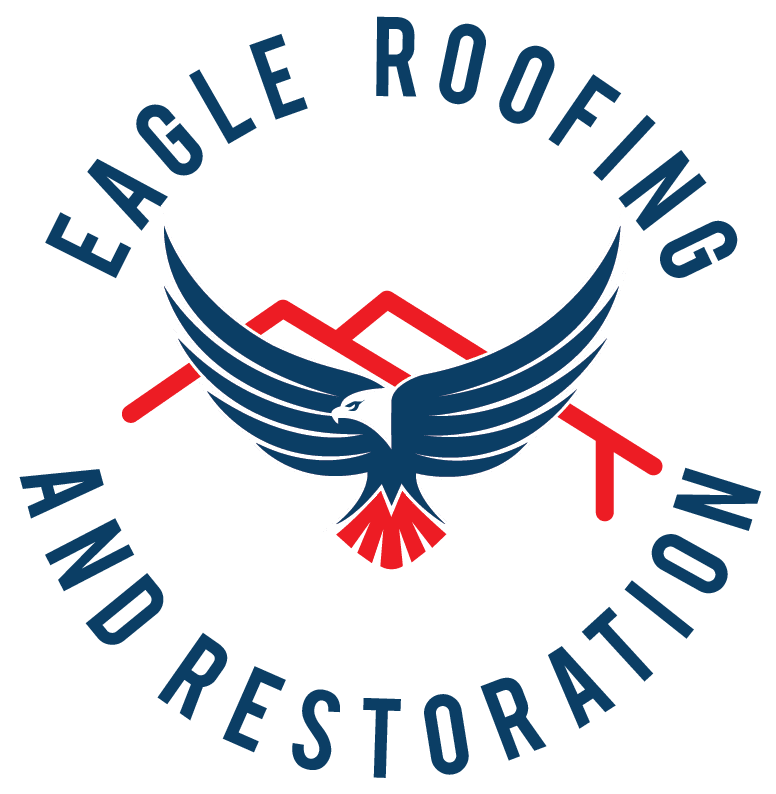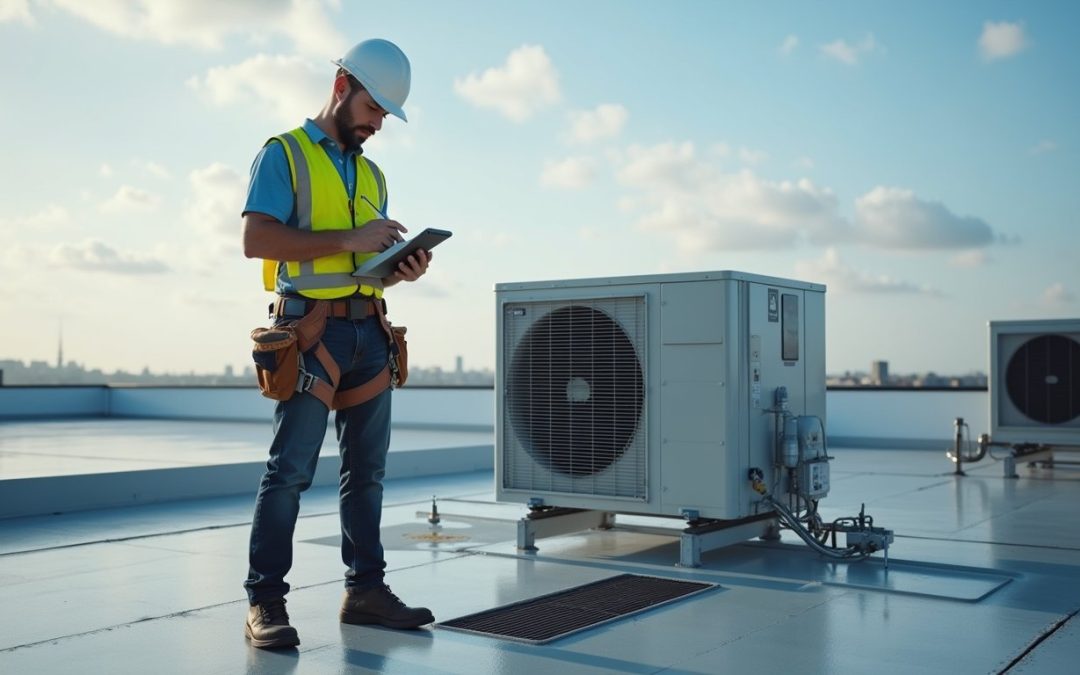To maintain your commercial roof in 2025, you’ll need to schedule bi-annual professional inspections, implement IoT sensor networks for real-time monitoring, and conduct quarterly drainage system cleanings. Don’t skip regular surface examinations for damage, ventilation system maintenance, and immediate repairs of any issues. You should also upgrade to climate-resilient materials, establish emergency protocols, train your staff, and maintain detailed digital documentation. Let’s explore each essential step to protect your valuable asset.
Schedule Regular Professional Inspections
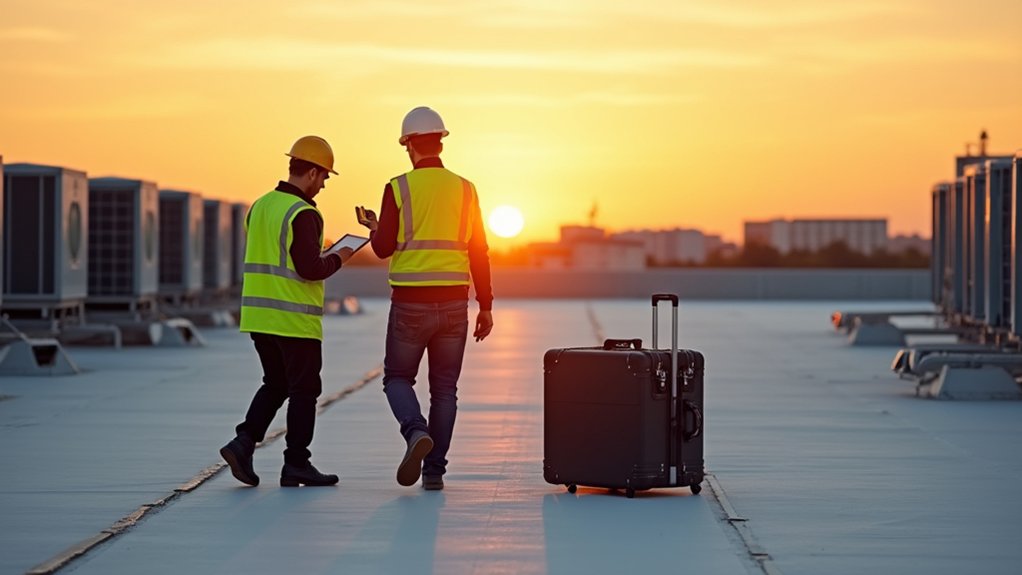
Professional roof inspections should be scheduled at least twice per year once in spring and once in fall to identify potential issues before they become costly problems. You’ll want to partner with experienced inspectors who understand commercial roofing systems and can detect early warning signs of deterioration.
Schedule routine assessments that include thorough examination of flashings, drainage systems, seams, and penetration points. Your inspector should document all findings with detailed reports and photos, providing you with clear recommendations for necessary repairs or preventive maintenance.
Don’t wait for visible leaks or damage to appear. Regular inspections help you maintain warranty compliance, extend your roof’s lifespan, and prevent unexpected business disruptions. By establishing a consistent inspection schedule, you’ll protect your investment and avoid emergency repair costs.
Implement Smart Monitoring Systems
You’ll gain critical insights into your commercial roof’s performance by implementing an IoT sensor network that monitors temperature, moisture levels, and structural integrity in real-time. These smart systems can detect leaks and potential failures before they escalate into costly repairs, helping you maintain ideal roof conditions year-round. Your maintenance team will receive instant alerts through mobile apps or dashboard interfaces when issues arise, enabling swift response to prevent water damage and extend your roof’s lifespan.
IoT Sensor Network Benefits
Installing an IoT sensor network on commercial roofs transforms traditional maintenance into a data-driven, proactive strategy. You’ll gain real-time insights into your roof’s performance through advanced data analytics, allowing you to detect issues before they become costly problems.
These smart sensors monitor critical parameters like moisture levels, structural strain, and temperature variations. They’ll help you optimize energy efficiency by identifying areas of heat loss and poor insulation. You’ll receive instant alerts when conditions exceed preset thresholds, enabling swift response to potential leaks or structural concerns.
Real-Time Leak Detection
While traditional roof inspections rely on visual assessments, smart monitoring systems equipped with moisture sensors and electrical conductivity probes can instantly detect water infiltration. You’ll gain immediate alerts when leaks occur, allowing for rapid response before extensive damage develops. Predictive analytics integrate with roof condition monitoring to forecast potential failure points.
- Install networked moisture sensors at critical roof areas to detect water penetration within minutes, not days or weeks after damage occurs
- Deploy smart monitoring dashboard that tracks moisture levels, sending automated alerts to your maintenance team when readings exceed normal thresholds
- Utilize predictive analytics to identify deteriorating conditions before leaks develop, based on historical sensor data and weather patterns
This proactive approach helps you prevent costly repairs and extends your roof’s lifespan through early intervention.
Clear Drainage Systems and Gutters
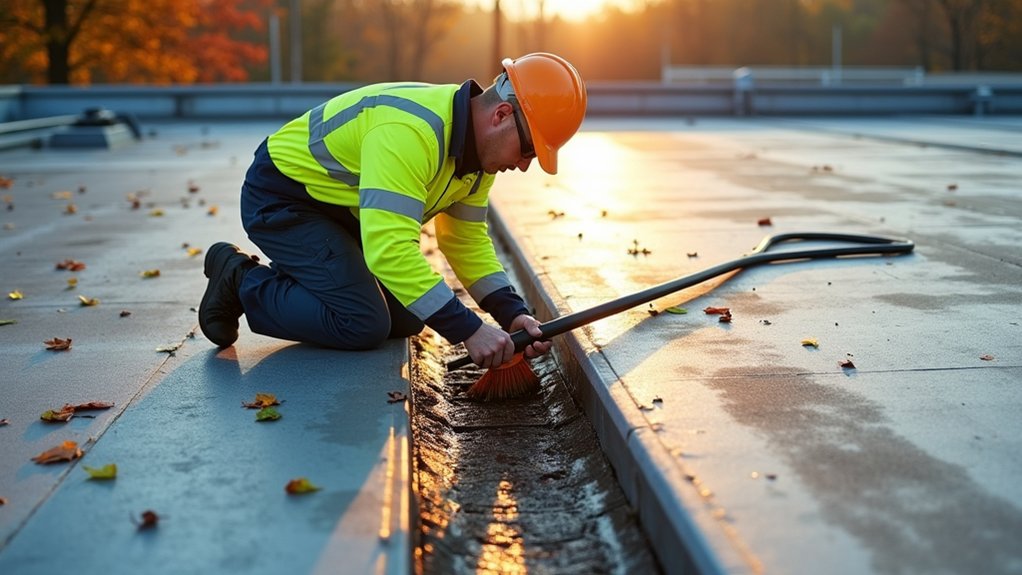
Because clogged drainage systems can lead to costly water damage, clearing gutters and drains should be a top priority in your commercial roof maintenance routine. Implement scheduled gutter cleanings at least quarterly, focusing on removing leaves, debris, and sediment that can impede water flow.
Install gutter guards to minimize debris accumulation and reduce maintenance frequency. You’ll need to conduct proactive clogged drain removal by using professional-grade drain snakes and high-pressure water jets to clear stubborn blockages. During inspections, check for signs of rust, loose fasteners, or separated seams that could compromise drainage efficacy.
Don’t forget to examine downspouts and guarantee they’re properly directing water away from your building’s foundation. When you discover drainage issues, address them immediately to prevent water pooling and potential structural damage.
Address Surface Damage Immediately
Surface damage on commercial roofs demands swift attention, as even minor issues can escalate into major structural problems when left unchecked. To identify surface damage sources effectively, you’ll need to conduct regular inspections and monitor roof condition trends. This proactive approach helps prevent costly repairs and extends your roof’s lifespan.
- Examine your roof’s surface for blistering, cracking, or punctures after severe weather events, and document any changes in material integrity
- Track patterns of wear and deterioration to identify surface damage sources, which often stem from foot traffic, equipment installation, or environmental factors
- Schedule immediate repairs when you spot membrane separations, loose flashings, or compromised seals – don’t wait for leaks to appear
Maintain Proper Ventilation Systems
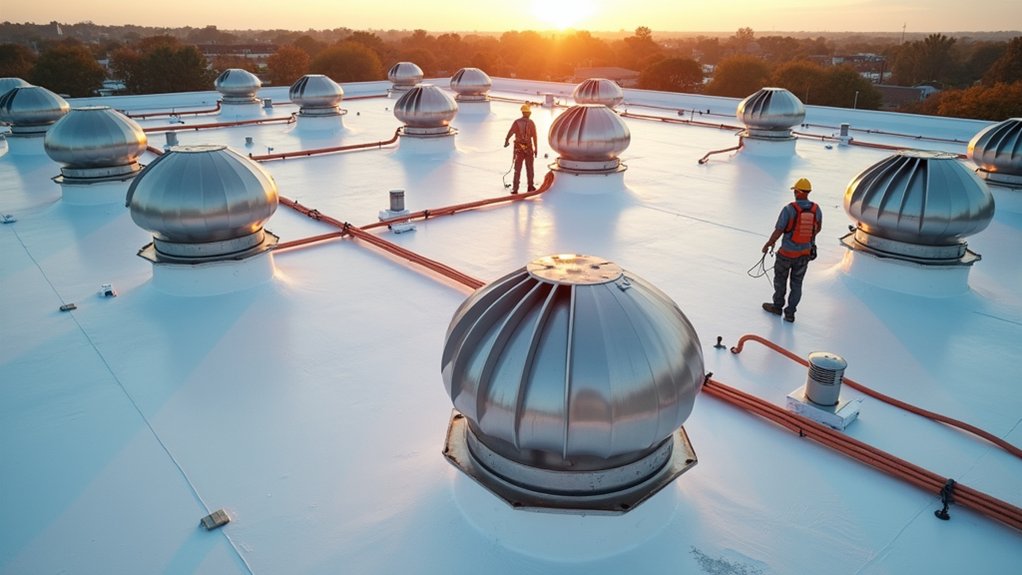
You’ll need to check your ventilation flow at least quarterly to maintain proper airflow through your commercial roof system. Clear away debris, leaves, and other obstructions from intake and exhaust vents to prevent moisture buildup and heat retention issues. Your rooftop ventilation inspection should include examining vent seals, caps, and mechanical components to guarantee they’re functioning at maximum capacity.
Check Ventilation Flow Regularly
Regular inspection of ventilation systems plays a pivotal role in maintaining commercial roof integrity. You’ll need to test air flow levels consistently and monitor ventilation ductwork to ensure ideal performance and prevent moisture-related damage to your roofing structure.
- Test air flow using calibrated meters quarterly to identify potential blockages, guaranteeing proper air exchange rates meet building code requirements and manufacturer specifications
- Monitor ventilation ductwork monthly for signs of damage, deterioration, or disconnection that could compromise the system’s efficiency and lead to condensation issues
- Document all readings and inspection results in a maintenance log, tracking performance trends and addressing any variations that fall outside acceptable parameters
These proactive measures will help maintain proper air circulation, prevent excess moisture accumulation, and extend your commercial roof’s lifespan.
Clear Vent System Obstructions
When vent systems become obstructed with debris, leaves, or nesting materials, your commercial roof’s ventilation efficiency drops markedly, leading to moisture buildup and potential structural damage.
To maintain ideal airflow, you’ll need to conduct preventative maintenance on all ventilation components at least quarterly. Remove any visible blockages from intake and exhaust vents, and clear accumulated debris from vent covers and screens. Don’t forget to check soffit vents and ridge vents for signs of pest infiltration or material buildup.
Monitor for blockages by inspecting your ventilation system’s performance regularly. You’ll want to measure airflow rates and watch for unusual sounds or odors that might indicate obstruction. If you notice decreased ventilation efficiency, schedule immediate cleaning to prevent long-term damage to your roof’s structure and underlying materials.
Document All Maintenance Activities
Thorough documentation of all roof maintenance activities serves as a critical business record and warranty protection measure. You’ll need to document maintenance schedules and maintain exhaustive records of every inspection, repair, and modification made to your commercial roof system.
- Create detailed digital logs that include dates, specific work performed, contractor information, and photographic evidence of completed maintenance tasks
- Store warranty documents, inspection reports, and repair receipts in a centralized system that’s easily accessible to facility managers and maintenance teams
- Track all expenses related to roof maintenance, including materials used, labor costs, and any specialized equipment rentals
This systematic documentation approach helps you monitor roof performance, plan preventive maintenance, validate warranty claims, and make informed decisions about future roof investments.
Upgrade Roofing Materials for Climate Resilience
Climate change demands robust upgrades to commercial roofing materials to withstand increasingly severe weather patterns. You’ll need to evaluate your current roofing system and consider implementing sustainable roofing materials that can handle extreme temperatures, heavy rainfall, and intense UV exposure.
Start by upgrading to impact-resistant membranes and installing energy efficient insulation upgrades that enhance thermal performance. You should select materials with high solar reflectance indices (SRI) to minimize heat absorption and reduce cooling costs. Consider installing green roofing systems or cool roof coatings that provide additional environmental benefits while extending your roof’s lifespan.
Don’t forget to assess your building’s structural capacity before making these upgrades. You’ll want to verify your facility can support the weight of new materials while meeting local building codes and climate resilience standards.
Establish Emergency Response Protocols
In your commercial roof emergency response plan, you’ll need a detailed list of emergency contacts including your roofing contractor, insurance agent, and first responders. Establish clear protocols that specify exactly when and how to contact each party, with step-by-step procedures for different emergency scenarios like leaks, storm damage, or structural concerns. Post these procedures in accessible locations and guarantee your facility management team knows how to quickly execute the response plan during urgent situations.
Document Emergency Contact Numbers
Maintaining a readily accessible list of emergency contact numbers is pivotal for swift response during roofing emergencies. You’ll need to document critical contacts and maintain updated contact logs to guarantee you’re prepared for any situation that requires immediate attention.
- Create a digital and physical directory that includes your roofing contractor, building maintenance team, and insurance provider’s direct lines. Store this information in your facility management system and post it in accessible locations.
- Update your contact list quarterly, verifying all numbers and adding new service providers or removing obsolete contacts. Include after-hours numbers and alternative contacts for each service.
- Share the emergency contact protocol with all facility managers and staff members, ensuring they know exactly whom to call for specific roofing emergencies like leaks, storm damage, or structural concerns.
Create Quick Response Procedures
Establishing clear emergency response protocols guarantees your commercial roofing system remains protected during critical situations. You’ll need to develop quick response checklists and emergency preparedness plans that detail specific actions for various scenarios.
| Emergency Type | Initial Response | Follow-up Actions |
|---|---|---|
| Water Leaks | Contain water flow | Document damage |
| Storm Damage | Secure loose materials | Schedule inspection |
| Structural Issues | Evacuate affected area | Contact engineer |
| Heavy Snow | Monitor load levels | Remove if necessary |
| Power Failures | Check drain systems | Verify backup power |
Ensure your maintenance team can access these procedures 24/7 through digital platforms and physical copies. Update your protocols quarterly, incorporating lessons learned from previous incidents and new industry best practices. Train your staff regularly on these procedures to maintain readiness and minimize response time during emergencies.
Train Staff on Basic Maintenance Procedures
Properly trained maintenance staff serve as your first line of defense against commercial roof deterioration. Implementing thorough employee training programs guarantees your team can identify potential issues before they become costly problems. When developing your maintenance schedule best practices, focus on essential skills and regular upkeep procedures.
Well-trained maintenance teams are essential guardians of your commercial roof, preventing small issues from becoming major expenses.
- Train staff to conduct monthly visual inspections, checking for ponding water, membrane damage, and clogged drainage systems
- Establish clear documentation protocols for reporting issues, including standardized forms and photo documentation procedures
- Provide hands-on training for basic maintenance tasks like debris removal, drain cleaning, and minor repairs that don’t require professional intervention
Plan for Seasonal Weather Challenges
As weather patterns shift throughout the year, your commercial roof faces unique seasonal challenges that require specific preventive measures. Plan for temperature fluctuations by inspecting expansion joints and flashings that may contract or expand with thermal changes. Schedule quarterly inspections to identify potential weak points before severe weather strikes.
To mitigate extreme weather events, guarantee your drainage systems can handle heavy rainfall and snow melt. Install heat cables to prevent ice dams in winter, and reinforce membrane seals before hurricane season. You’ll need to adjust your maintenance schedule based on your region’s specific climate patterns. Document historical weather data to anticipate seasonal stressors and develop targeted response protocols. Keep emergency repair materials on hand and maintain relationships with reliable contractors for rapid response during weather-related emergencies.
Frequently Asked Questions
How Much Does a Complete Commercial Roof Replacement Typically Cost?
You’ll typically spend between $5-15 per square foot for a commercial roof replacement, though costs can range from $50,000 to $500,000+ depending on your building’s size and roof type. You can reduce long-term expenses through regular roof inspection frequency (quarterly checks) and applying commercial roof coatings, which extend your roof’s lifespan. Your total cost will vary based on materials chosen, local labor rates, and existing roof condition.
What Insurance Coverage Should I Have for My Commercial Roof?
You’ll want extensive property insurance that specifically includes roof coverage in your policy coverage. Guarantee it safeguards against common perils like storms, hail, fire, and wind damage. It’s vital to comprehend your deductible amounts and coverage limits typically, you should have coverage equal to your roof’s replacement cost. Contemplate adding business interruption insurance to shield against income loss during repairs. Examine and update your policy annually to sustain sufficient protection.
Can Solar Panels Be Installed on Any Type of Commercial Roof?
Not all commercial roofs can support solar panels. You’ll need to evaluate your roof’s structural integrity before installation. Most flat or low-slope roofs made of TPO, EPDM, or metal are compatible with solar panels, but you’ll need a professional assessment to confirm solar panel compatibility with your specific roof system. Key factors include weight-bearing capacity, roofing material condition, and mounting options. Don’t proceed without an engineer’s verification of your roof’s load capacity.
How Long Should a New Commercial Roof Warranty Last?
You’ll typically find that commercial roof warranties range from 10 to 30 years, depending on the roofing material and manufacturer. To maintain your warranty’s validity, you’ll need to follow a strict roof maintenance schedule and meet professional inspection requirements, usually twice per year. It’s pivotal that you document all inspections and repairs, as warranty coverage often depends on proof that you’ve properly maintained the roof according to the manufacturer’s specifications.
What Signs Indicate It’s Time to Replace Rather Than Repair?
You’ll need to evaluate replacement when you notice multiple visible leaks throughout the building or extensive visible roof damage that affects more than 25% of the surface. Watch for widespread blistering, large areas of ponding water, severe membrane deterioration, or significant structural sagging. If repair costs exceed 30% of replacement value or you’re experiencing recurring issues despite repairs, it’s time to invest in a new roof system.
